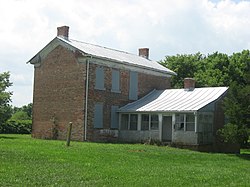James and Sophia Clemens Farmstead
James and Sophia Clemens Farmstead | |
 Front and side of the farmhouse | |
| Nearest city | 467 Stingley Rd., Palestine, Ohio |
|---|---|
| Coordinates | 40°4′39″N 84°47′43″W / 40.07750°N 84.79528°W |
| Area | 4 acres (1.6 ha) |
| Built | 1850 |
| Architectural style | I-house |
| NRHP reference No. | 01000199[1] |
| Added to NRHP | March 15, 2001 |
The James and Sophia Clemens Farmstead is a historic farm situated in western Darke County, Ohio, United States. Located at 467 Stingley Road,[1] approximately 1 mile (1.6 km) from the Indiana border,[2] it is among the oldest remaining buildings of a small community of free African-Americans founded before the Civil War.[3]

Natives of Rockingham County, Virginia,[4] James and Sophia Clemens settled in Darke County in 1818 and became prosperous farmers. Their success led other former slaves to migrate to the vicinity, and a community known as "Longtown" (alternately "Tampico"[4]) gradually grew up in the vicinity of the Clemens farm. Over the years, the community became a center for the Underground Railroad, complete with a Quaker school known as the Union Literary Institute; among the movement's leaders in the community were the Clemens family.[3]
The Clemens house itself was erected circa 1850 on land purchased in 1822.[5] The two-story brick I-house rests on a limestone foundation and is covered with a tin roof.[6] Though the house is presently uninhabited, a movement to restore the house and designate Longtown a state historic landmark began in the mid-2000s.[5] The Clemens house itself has been designated a historic site, having been listed on the National Register of Historic Places in 2001, along with the other building on the property.[1] It qualified for the Register both because of its place in local history and its association with James Clemens, who was seen as a significant individual in the history of Darke County.[6]
See also[edit]
References[edit]
- ^ a b c "National Register Information System". National Register of Historic Places. National Park Service. March 13, 2009.
- ^ DeLorme. Ohio Atlas & Gazetteer. 7th ed. Yarmouth: DeLorme, 2004, 54. ISBN 0-89933-281-1.
- ^ a b James & Sophia Clemens Farmstead, National Park Service, n.d. Accessed 2010-08-15.
- ^ a b Wilson, Frazer. History of Darke County Ohio: From Its Earliest Settlement to the Present Time. Vol. 1. Milford: Hobart, 1914, 554.
- ^ a b Historic Ohio Town Fights 'Mega Dairy', National Public Radio, 2006-02-13. Accessed 2010-08-15.
- ^ a b Clemens, James and Sophia, Farmstead, Ohio Historical Society, 2007. Accessed 2010-08-15.



